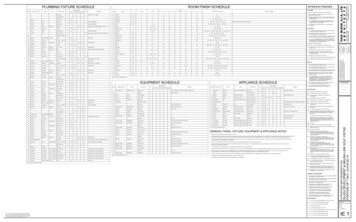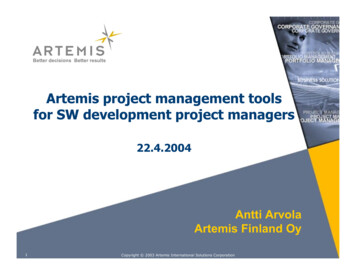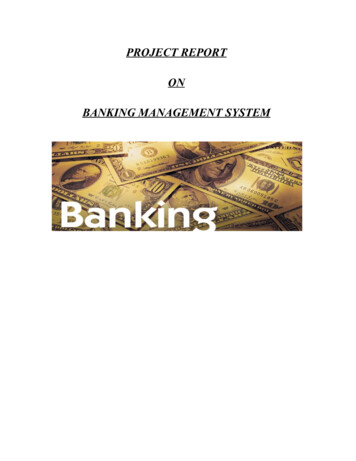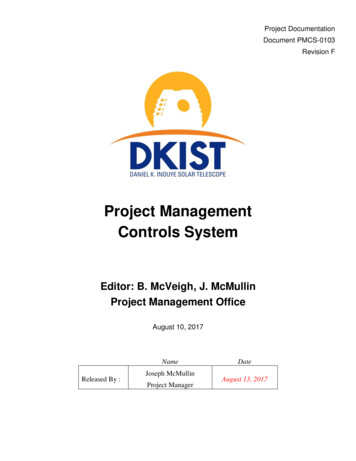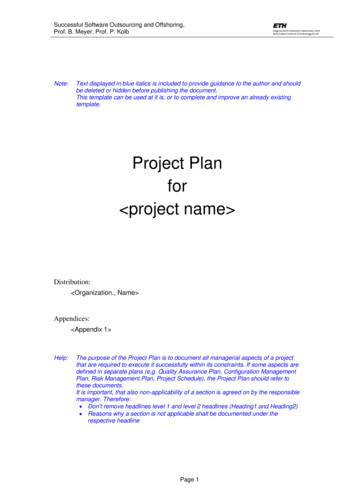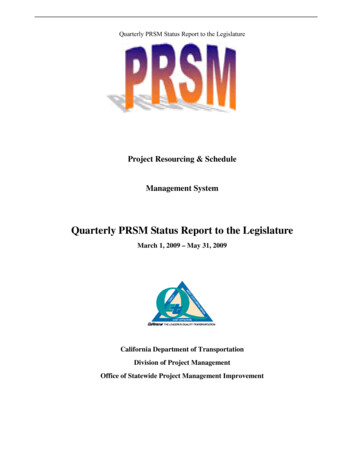
Transcription
Quarterly PRSM Status Report to the LegislatureProject Resourcing & ScheduleManagement SystemQuarterly PRSM Status Report to the LegislatureMarch 1, 2009 – May 31, 2009California Department of TransportationDivision of Project ManagementOffice of Statewide Project Management Improvement
Quarterly PRSM Status Report to the LegislatureTable of ContentsIndependent Project Oversight Reports . 1IPO Report for May, 2009 . 1Project Oversight Review Checklist for May, 2009 . 7IPO Report for April, 2009 . 11Project Oversight Review Checklist for April, 2009 . 16IPO Report for March, 2009 . 20Project Oversight Review Checklist for March, 2009 . 25
Quarterly PRSM Status Report to the LegislatureIndependentProjectOversightReportsIPO Report for May 2009Caltrans PRSMProject Name:Assessment Date:Frequency:May 29, 2009MonthlyOversight Provider InformationOversight Leader:Greg ThomasOrganization:Phone Number:916 288 3232Email:Deloitte & Touche LLPgrethomas@deloitte.comProject InformationProject Number:2660-160Department:Transportation (Caltrans)Criticality:HighAgency:Business, Transportation & HousingLast ApprovedDocument/Date:SPR (09/29/08)Total One-timeCost: 26,119,068Start Date:June 7, 2000End Date:January 6, 2011Project Manager:David YoumansOrganization:CaltransPhone Number:916.826.4425Email:david youmans@dot.ca.govSummary: Current StatusProject Phase:PlanningPlanned Start Date:September 2, 2008Planned End Date:October 6, 2008Actual Start Date:March 5, 2009Forecasted End Date:July 8, 2009ScheduleSelect the statement that most closely applies, measured against the last Finance approved document.Ahead-of-schedule:One or more major tasks or milestones have been completed and approved early ( 5%).All other major tasks and milestones completed and approved according to plan.On ScheduleOn-schedule:All major tasks and milestones have been completed and approved according to plan.(Within 5%)Behind Schedule:One or more major tasks or milestones are expected to be delayed. ( 5%)Comments:A new baseline schedule was set with the approved SPR dated September 29, 2008. The SPRstates the start date of the Planning Phase as September 2, 2008, however, the final contract wassigned by the Implementation Vendor on February 26, 2009. Caltrans received, reviewed and signedPage 1 of 28
Quarterly PRSM Status Report to the Legislatureththe contract on February 27, 2009. DGS Legal reviewed and signed the contract on March 5 , 2009The current SPR appears to be inconsistent with the new actual dates. Based on conversations withthe Caltrans PRSM IT Project Manager, an updated SPR with a new baseline has been drafted anddiscussed with the OCIO. The draft SPR has been submitted to the Caltrans PMO office for review.The updated SPR will more accurately reflect the actual start date of the contract.Based on the draft SPR and information distributed during the PRSM kick-off meeting, the PlanningPhase was forecasted to end in May 2009. In the May 26, 2009 PRSM Project Status meeting, theImplementation Vendor identified the Planning Phase completion date as July 8, 2009. Thisrepresents a difference of two months. Based on conversations with the Caltrans PRSM ProjectManager, the PRSM Project Team plans on completing activities scheduled for the Adaptation Phase(the phase after Planning) in parallel with activities in the Planning Phase. At this point in time, thePRSM Project Team does not anticipate the two month delay in the Planning Phase to affect thecompletion date of the entire project. Based on this information, IPOC has reported the project as“On Schedule”, however, we will continue to closely monitor the Planning Phase status and startdates of parallel tasks in the Adaptation Phase.Resources (Level of Effort) Choose the statement that most closely applies.Fewer ResourcesCompletion of one or more major tasks and/or acceptable products has required or isexpected to require materially ( 5%) fewer hours/staff than planned.Within ResourcesWithin ResourcesAll major tasks have been completed and acceptable products created using the plannednumber of hours/staff (within 5%).More ResourcesCompletion of major tasks and/or acceptable products has required or is expected to requirematerially ( 5%) more hours/staff than planned.Comments:A new baseline was set with the approved SPR.Resources (Budget/Cost) Choose the statement that most closely applies.Less costThe project is ( 5%) under budget.Within CostWithin costThe project is operating within budget.Higher costMaterial budget increases ( 5%) are likely.Comments:A new baseline was set with the approved SPR.Quality (Client Functionality) Choose the statement that most closely applies.Adequately DefinedRequired client functionality is adequately defined, and is being successfully built into thesystem, given the current project phase.Adequately DefinedComments:Inadequately DefinedOne or more significant components of required client functionality are inadequately defined,or are not being successfully built into the system, given the current project phase.Functionality is adequately defined for the Planning Phase which began on March 5, 2009. TheImplementation Vendor is currently reviewing the requirements and will be working with Caltrans to create arequirements clarification report, which is due to be completed in June, 2009.Quality (Architecture/System Performance) Choose the statement that most closely applies.Page 2 of 28
Quarterly PRSM Status Report to the LegislatureAdequately DefinedThe system technical architecture is adequately defined, and modeling, benchmarking andtesting are being conducted (or are planned) appropriate to the current project phase.Adequately DefinedComments:Inadequately DefinedThe system technical architecture is not adequately defined, or modeling, benchmarking andtesting are not being conducted (or are planned) appropriate to the current project phase.System technical architecture and performance are adequately defined for the Planning Phase. TheImplementation Vendor is working with Caltrans to create a Configuration Management Plan and High LevelDesign. Caltrans and the Implementation Vendor are working with DTS to configure the development,testing and training environments. As the project progresses, additional refinement may be necessary.Page 3 of 28
Quarterly PRSM Status Report to the LegislatureNew RisksNo new risks this month.Progress Toward Addressing Prior RisksRisk Title: Timing of InterfacesRisk Statement: With a new Caltrans financial systems project underway (ERP Financial Infrastructure – “EFIS”), an additional interfacewill need to be developed. The PRSM project is currently planning to develop an interface to the Caltrans Financial Data to Oracle(FIDO) system, which is the Caltrans enterprise financial system that is currently used for operations. The timing for development of theEFIS interface is tentatively planned for September 2009, although the specifications and data requirements are not fully documented atthis time. The uncertainties associated with the EFIS interface may have an impact on development and testing resources (potentiallyincreasing development and testing costs) and a potential adverse impact on the project schedule (delay in development of the PRSMsolution).Probability: High Impact: Medium Time Frame: Short TermSeverity: HighAssigned to: Jacqueline MooreRecommendations:Continue to work closely with the EFIS project by attending the bi-weekly interface planning meetings. Escalate issues related to EFIStiming and resource needs to the PRSM Steering Committee for resolution as soon as the interface requirements are finalized.Status Update:May 09 Status:April 09 Status:The PRSM team is currently attending bi-weekly meetings with the EFIS project team to discuss the interfacerequirements and plan for development of the interface. Two items on the PRSM Project Plan regarding interfaces weremoved out of the Planning Phase and will be placed in a more appropriate phase, when the interface points will be morestable. The two items were: Develop Baseline Interface Design Specification and Interface Modeled into BusinessProcess.The PRSM team is currently attending bi-weekly meetings with the EFIS project team to discuss the interfacerequirements and plan for development of the interface.Risk Title: Resource AvailabilityRisk Statement: Without adequate Caltrans resources working on PRSM, the project implementation schedule could be delayed. Whilein the Planning Phase, some of the PRSM Project Team members are allocated part time. The resource needs are likely to change whenthe project shifts to the Implementation Phase.Probability: Medium Impact: HighTime Frame: ShortSeverity: HighAssigned to: TBDRecommendations:After the PRSM work plan is complete, determine the resource gaps and reallocate effort as appropriate.Status Update:May 09 Status:April 09 Status:As part of the Planning Phase of the project and in conjunction with the Implementation Vendor, the PRSM ProjectTeam will establish possible changes to resource needs and roles/responsibilities. On May 19, 2009, theImplementation Vendor requested different critical path resources for the following functions: Configuration, Interfaces,and Data Conversion. The Business Project Manager is still acting as the interim publicity /communications manageruntil the position can be filled.As part of the Planning Phase of the project and in conjunction with the Implementation Vendor, the PRSM ProjectTeam will establish possible changes to resource needs and roles/responsibilities. Since the Planning Phase isunderway, it is too early to determine if a significant change in Caltrans PRSM resource assignments will be necessary.Currently, the Business Project Manager is acting as the interim publicity/communications manager until the positioncan be filled.Page 4 of 28
Quarterly PRSM Status Report to the LegislatureRisk Title: Business Rules and Business Process ChangesRisk Statement: The impact of business changes resulting from the PRSM implementation needs to be sufficiently understood, plannedfor, and communicated to Caltrans staff. If District field staff are not in agreement with the decisions and consequences ofchanging/standardizing business rules and business processes, it may have an adverse effect on system acceptance and may disrupt workin progress. This could result in increased resistance to acceptance and usage of the system.Please note that this risk was documented in the previous IPOR’s as 2 separate risks: “Business Rules” and “Business Process Changes”.Beginning in this IPOR and going forward, these risks have been consolidated.Probability: High Impact: HighTime Frame: MedSeverity: HighAssigned to: David CordoneRecommendations:Implement a formal change management process which will be used for PRSM project related changes. Change management tasksassociated with these changes should be incorporated into the project schedule and budget. Changes should be communicated to thekey stakeholders. Define the process for gaining field consensus on the new business rules and business processes. Develop a plan that describes how information on new business rules and business processes will be communicated to the field withsufficient time to get feedback and buy-in.Status Update:May 09 Status:The Implementation Vendor is completing their review of the “to be” business process documents. Once the “to be”business process documents have been released to the Districts, a video conference will be scheduled with each Districtindividually to discuss the final processes and rules as well as address any District concerns. PRSM Task Managementand Reporting continue to be the key areas that need to be addressed from a business process standpoint.April 09 Status:As part of the Planning Phase and in conjunction with the Implementation vendor, the PRSM team is going through aprocess to take the planned “to be” business processes and work the CA Clarity Project Management tool (the toolselected as the PRSM solution) in order to identify gaps. As these gaps are identified and consolidated, there will be aprocess to obtain feedback from the Districts. Currently, the PRSM Project Team is preparing to release the finalversion of the “to be’ business process documents to the Districts. Once they have been released, a video conferencewill be scheduled with each District individually to discuss the final processes as well as address any District concerns.PRSM Task Management and Reporting continue to be the key areas that need to be addressed from a business processstandpoint.General CommentsPage 5 of 28
Quarterly PRSM Status Report to the LegislatureDeloitte & Touche LLP’s IPOC contract with the Caltrans PRSM project started in December 2008. This IndependentProject Oversight Report (IPOR) provided by Deloitte & Touche LLP has been developed in accordance with the applicablestandards of the American Institute of Certified Public Accountants (AICPA) as per Deloitte & Touche LLP policy.IPOC has attended various PRSM project meetings throughout the month of May, including the PRSM ImplementationManagers meeting and the PRSM Status meetings.At the end of this reporting period, the PRSM project is in the Planning Phase of the project. Three deliverables have beenidentified to be completed during the Planning Phase: the Implementation Plan, Training Plan, and Configuration ManagementPlan. IPOC will review each of the plans and provide comments after they have been drafted and deemed ready for review.Beginning in this reporting period, PRSM project status meetings have been occurring on a weekly basis versus bi-weekly.During the status meetings, the Implementation Vendor distributes an updated status report, which includes an updatedschedule in Microsoft Project for the Planning Phase. The schedule provides a detailed view of the status of activities,deliverables, and milestones for the Planning Phase. In addition, the status report also includes a Past Due Task StatusRegister and an Action Item / Decision Register. Additional phase schedules will be created and distributed as the projectprogresses into the subsequent phases. The Implementation Plan deliverable in Payment Point 1 will encompass the completeproject schedule.Based on conversations with the Caltrans PRSM IT Project Manager, an updated SPR with a new baseline is being drafted.Based on the draft SPR and information distributed during the PRSM Kick-off meeting, the Planning Phase was forecasted toend in May 2009. In the May 26, 2009 PRSM Project Status meeting, the Implementation Vendor identified the PlanningPhase completion date as July 8, 2009. This represents a difference of two months. Based on conversations with the CaltransPRSM Project Manager, although the Planning Phase schedule has been extended by two months, the PRSM Project Teamplan on completing several activities in parallel. For more information, please refer to the Schedule section of Page 1 of thisIPOR.Key activities during the Planning Phase include development and approval of the Implementation, Training and ConfigurationManagement Plans, and installation of the CA Clarity Hardware and Software environments at the Department of TechnologyServices (DTS). In addition to the key activities, during this reporting period, the Implementation Vendor submitted a DraftCommunications Plan for the PRSM Project Team to review. Feedback and comments were collected by the PRSM ProjectTeam and submitted to the Implementation Vendor. Currently, the Implementation Vendor is in the process of reviewing thecomments and incorporating the feedback into an updated Draft Communications Plan.As of May 29, 2009, the following Planning Phase work items below are noted as being Past Due and are being tracked byIPOC:1.‘To Be’ Business Process Refinement – The ‘to be’ process refinement effort was delayed by a week due to anImplementation Vendor Consultant illness. The Implementation Vendor is currently in the process of completing thisactivity.2.DTS Hardware Installation – There were two issues associated with the PRSM server at DTS that created a delay ingetting the development environment fully operational: An unsupported Operating System version was installed atDTS and access to certain network ports were closed. Currently, DTS has resolved those issues and the SoftwareVendor Consultant is in the process of configuring three instances of PRSM: Development, Test, and Training.3.Rollout Order – The PRSM District rollout order has not been finalized. The rollout order will consist of seven“clusters” of sites; however, the order of those clusters has not yet been identified.Please note that while these items are Past Due, IPOC’s current assessment is that their status will not impact the “OnSchedule” assessment on page 1 of this report.Page 6 of 28
Quarterly PRSM Status Report to the LegislatureProject Oversight Review Checklist for May 2009Project Oversight Review Checklist: High Criticality ProjectThis checklist is an assessment for the Planning Phase. The end date of this phase is July 2009.Practices and ProductsAdequateDeficientNotes: Items Reviewed; Interviews Conducted;DemonstrationPlanning and TrackingHave the business case, project goals, objectives, expected outcomes, keystakeholders, and sponsor(s) identified and documented?XHas a detailed project plan with all activities (tasks), milestones, dates, andestimated hours by task loaded into project management (PM) software?Are the lowest level tasks of a short duration with measurable outcomes?XIs completion of planned tasks recorded within the PM software?XAre actual hours expended by task recorded at least monthly within PMsoftware?Are estimated hours to complete by task recorded at least monthly withinPM software?XIs there a formal staffing plan, including a current organization chart,written roles and responsibilities, plans for staff acquisition, schedule forarrival and departure of specific staff, and staff training plansHave project cost estimates, with supporting data for each cost category,been maintained?XXXThe SPR was approved by the OCIO on September 29, 2008. The Section 11 wassubmitted and the waiting period ended Dec 5. The appropriate project documentsshould be updated with the new information from the SPR and ImplementationVendor information. An updated SPR with a new baseline has been drafted anddiscussed with the OCIO. The draft SPR has been submitted to the Caltrans PMOoffice for review.During the Planning Phase, the Implementation Vendor is working with Caltrans toupdate the detailed project plan in MS Project to more accurately reflect and trackproject tasks, milestones, dates, and estimated hours. The Planning Phase WBSwith approximately 60 tasks has been entered in MS Project. An overall projectWBS/task list of approximately 2,000 items exists in an Excel file. These activitiesare appropriate for the Planning Phase of the project.During the Planning Phase, the Implementation Vendor is working with Caltrans toupdate the detailed project plan in MS Project to more accurately track completionof planned tasks. This is appropriate for the Planning Phase of the project.Actual hours are charged to a WBS number and are recorded and tracked in theDepartment’s official account
Mar 01, 2009 · The system technical architecture is adequately defined, and modeling, benchmarking and testing are being conducted (or are planned) appropriate to the current project phase. . (ERP Financial Infrastructure – “EFIS”), an additional interface will need to be developed. The PRSM project is currently planning to develop an interface to the .

